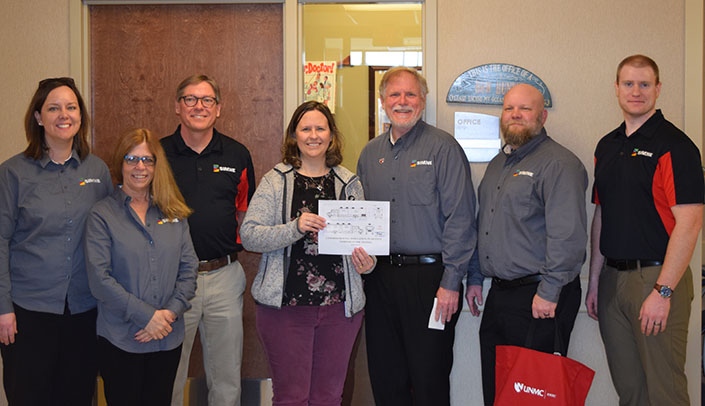The UNMC Simulation in Motion-Nebraska program (SIM-NE) recognized its 5,000th trainee at the Valley County Health System in Ord on March 21.
Jane Meyer, a nurse practitioner of the Valley County Health System in Ord, is the 5,000th trainee. The SIM-NE team presented her with a commemorative plaque, as well as merchandise from SIM-NE and the Interprofessional Experiential Center for Enduring Learning (iEXCEL) at UNMC.
“We thank critical access hospitals and emergency medical service agencies that have invited us out to conduct training,” said Doug Dekker, program manager of SIM-NE. “We appreciate the opportunity to train with their teams and look forward to continuing simulation training across the state.
“A big thank you also to the SIM-NE team of instructors across the state that have made training 5000 people possible. We could not have reached this milestone without them.”
SIM-NE is a statewide, mobile education system that takes state-of-the-art, hands-on training to emergency medical service (EMS) providers in rural areas across the state, including health professionals in hospitals. SIM-NE provides free training using four, 44-foot-long, customized trucks that supply mobile, real-life experiences designed to enhance lifesaving skills for those in rural areas. It has trained personnel in 87 of 93 Nebraska counties.
SIM-NE’s four trucks were launched in 2017 and stationed in the Nebraska communities of Scottsbluff, Norfolk, Kearney and Lincoln. Rather than having learners travel to larger cities, the training is at the request of rural emergency medical service agencies and critical access hospital staff and is done in their communities. This also allows training to be team-based as learners train side-by-side with the people they normally work with during a response.
The customized trucks feature dual slide-out room extensions, a simulated emergency room and ambulance, a control room, as well as high-tech, computerized patient simulators that talk, breathe, have heartbeats, and can react to medications and other actions of the learners.
Each mobile unit is equipped to recreate a realistic environment for learners including: medical supplies; pre-programmed computerized medical and trauma scenarios; monitors that display vital signs of patient simulators; heart monitors/defibrillators; audio and video recording/playback capabilities and mock drugs.

Congratulations to the SIM-NE team, what an amazing program!